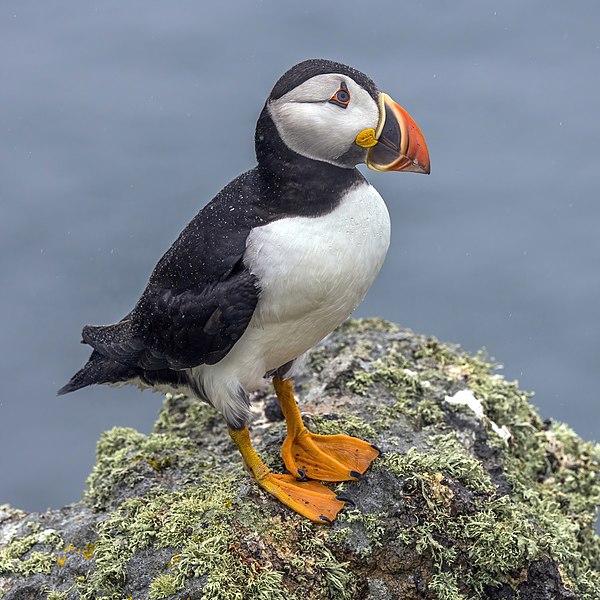The Great Puffin Toss

Pictured above is a puffin, a strangely cute bird that looks like a mix between a toucan and a penguin with duck-like feet. The puffin above is, specifically, an Atlantic puffin, and is native to the northern Atlantic Ocean — you’ll find them, among other places, in Iceland. They’re not an endangered species but their population has been in a slow decline; the International Union for Conservation of Nature lists them as “vulnerable,” which means that these puffins are “being threatened with extinction unless the circumstances that are threatening its survival and reproduction improve.”
Which is why, toward the end of every summer, Icelanders chase baby puffins down and throw them off of cliffs.
That seems counterproductive — and kind of evil! But it’s not. It actually helps.
Adult puffins can fly and are great swimmers, but it takes a few weeks for a newly hatched baby puffin, called a puffling, to get to that point. Puffins lay eggs on land in high elevations, typically near the edge of cliffs. Each mature female puffin typically lays one egg per year — and both parents share the incubation duties. After the puffling hatches, the baby spends roughly five to seven weeks in a burrow, avoiding sunlight (and predators). During those formative weeks, the bird’s parents come by often to feed their baby. When the puffling is to make a safe-ish descent off the cliff to the water below, it walks to the cliff edge and flies, kind of — at that point in its development, the pufflings don’t get much liftoff and can’t stay in the air too long. But it doesn’t have to because, again, it’s at the end of a cliff. The puffling of flutters off the cliff’s edge, letting gravity do most of the work while its still-developing wings soften the watery landing. And they do all of this alone. Pufflings don’t wait for their parents to take them to the water — they find their own way by letting the light of the moon.
It’s a tried and true system, which would work flawlessly but for something we call the “light bulb.” Pufflings, being birds, don’t know that us humans have created a way to replicate the glow of the moon, so when it’s time for the baby birds to make their way to the water, they often get lost. In the small Icelandic island and town of Vestmannaeyjabaer (here’s a map), streetlights and the like attract hundreds if not thousands of baby puffins each year, and (for good reason) Vestmannaeyjabaer’s downtown isn’t built on the wrong side of cliffs. The end result: a lot of lost pufflings.
So every August and September, the people of Vestmannaeyjabaer go on a puffling hunt. It’s a sight to behold as photographer Kyana Sue Powers told NPR: in the summer of 2021, “she was leaving a restaurant after dinner and noticed some strange behavior from children and adults carrying flashlights and boxes. ‘People were just running around the streets, like into corners and sidewalks and stuff, frantically chasing things,’ she said.” It turns out they were trying to capture some baby puffins. (Powers ended up taking a lot of photos of the efforts; you can find them at the NPR link.) And they’re successful; per Powers, volunteers usually catch about a half-dozen each night of the hunt each.
The puffling pursuit is a practical one. Starting at around 9 pm, the volunteers will spend hours searching for lost birds and chasing them down. The quest often lasts until just before dawn; as a reporter for Smithsonian Magazine shares, “There’s an unwritten rule around here [. . . ] You can’t quit until the puffling is safe.” Once a bird is captured, the volunteer will place the puffling into a grass-lined box until the next day. When the sun is up — we don’t want the birds flying back toward the artificial light source — the boxed birds are brought to the cliffside and released. Some volunteers just set the birds on the ground and hope they walk toward the cliff’s edge; others take a more direct approach and gently toss the birds in the right direction.
It’s fun for the people and good for the birds. While puffin tossing won’t, itself, keep the puffin population robust, it helps. As Mental Floss notes, “Though it looks cruel, the birds have no problem lifting off and flying safely toward their new home for the next few years. The unusual tradition helps ensure the puffins will be back to nest another year.”
Bonus fact: The puffin above looks like a parrot, kind of, but that’s not always the case. The colorful beak isn’t a year-round thing. The World Wildlife Fund explains: “Puffins only possess Technicolor bills—and their matching orange feet—during the spring breeding season. Just before winter sets in, they shed the colorful outer bill, leaving a noticeably smaller and duller-colored beak.”
From the Archives: How Luke Skywalker Beat the Puffins: He kept them, made them a different type of cute, and then… well, that’s really it.
